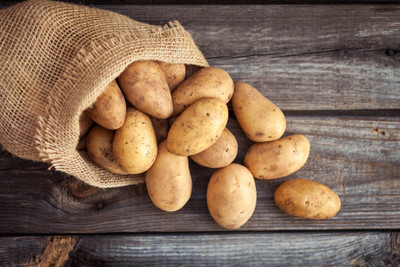Potato Nutrition Facts: They Can Be Good for You!
As a dietitian, there is one food I get questioned about frequently and that is potatoes. People are often wondering if potatoes are okay to eat or if they need to avoid them. Living in the Midwest where potatoes are a common side dish, I thought we would clear up the confusion as to whether potatoes are a nutritional powerhouse or something that should be avoided.
Potatoes have a bad reputation, but this is mainly due to how we eat them and the amount versus their nutritional properties. A small potato with the skin on is fat-, sodium-, and cholesterol-free, has more blood pressure lowering potassium than two medium bananas, and is a great source of fiber. All of these properties make a potato a great choice for heart health. In addition, potatoes have 20% of the daily value of vitamin C, significant niacin, folate, magnesium and phytochemicals. With 130 calories for a serving of potato, it is somewhat lower in calories and carbohydrates than a similar portion of rice or pasta.
However, consumer data shows that one-half to two-thirds of the potatoes Americans eat are either potato chips or French fries. One small serving of French fries or potato chips is at least double the calories, ten times the amount of fat, and less than half the vitamin C of a small potato.
Look at the difference:

For 5 ounces of a baked potato, there is less calories than 1 oz of either the potato chips or French fries. There is no fat in the baked potato but there is 10-13 grams in the other two foods.
Potatoes are considered a higher glycemic index food, meaning that their carbohydrates are quickly broken down into sugar.But the glycemic index does not take into account many other factors that effect our glucose response. So, monitor your blood sugar and see how potatoes effect your numbers. It may mean you need to pair potatoes with some lower carbohydrate items or watch your portion a little closer.
Let’s review some tips for making healthy choices with your spuds:
1. Keep the skin on - This is where you get the benefits from the fiber in the potato.
2. Stick with baking or microwaving - Boiling potatoes allows much of the vitamins and minerals to leach into the water. Baking or microwaving maintains 40-100% more potassium and two times the vitamin C as boiled. Avoid fried potatoes as they add unwanted fat and calories to your dish.
3. Watch your portion size - The serving size for potatoes is about the size of a fist. If you’re at a restaurant cut your potato in half and either share it with a friend or box it up to take home for another meal.
4. Limit add-ons - If you are watching your sodium and fat intake, be careful with all those toppings. At home, top with plain Greek yogurt, guacamole, or salsa instead of sour cream, butter and cheese to cut back on saturated fat and cholesterol.
5. Pair with other non-starchy vegetables - Since potatoes are higher in carbohydrate than other vegetables, its best to pair your potato with non-starchy vegetables, instead of corn and peas, to keep the total carbohydrate down for your meal.

Interested in eating healthy? Hungry for more?








 Weight Loss
Weight Loss Health & Wellness
Health & Wellness Diabetes
Diabetes Heart Health
Heart Health Motherhood & Family
Motherhood & Family Dietary Restriction
Dietary Restriction Other Health Conditions
Other Health Conditions About SSHE
About SSHE


